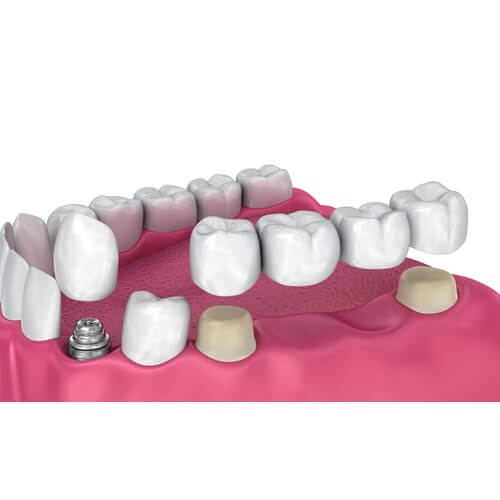Should I Get an Implant or a Bridge?
So the conversation went earlier this week.
On top of this patient’s questions is the fact that I am giving a lecture tomorrow to a group of dentists on the subject of dental implants in the front of the mouth. Yes, there can be differences between the front and the back of the mouth. At the lecture, I will be spending some time talking about which of the choices may be more appropriate in differing situations.
So I thought that since this subject of dental implants and bridges shows up no matter which direction I turn, I would spend some time sharing a few thoughts with you today.
To simplify things a bit, I will only be talking about permanent bridges in this column.
Defining Dental Implants and Bridges
First of all, let’s do some definitions.
Both dental implants and bridges are used to replace a missing tooth or teeth.
There is a fundamental difference between them.
When we utilize a dental implant, there is no focus on what is on either side of the implant. The only things that matter for the implant are quality and quantity of bone into which, the implant will be placed.
When we are dealing with a bridge, we need to shift our focus.
In a permanent bridge, it is all about the teeth on either side of the missing tooth or teeth. The bridge needs to anchor to those side teeth. Much like a bridge over water. The span is held up by the two or more vertical components of the bridge. In this regard, dentistry is no different.
So what influences which is the best treatment for that patient?
Factors that determine the best treatment option
The Number of Missing Teeth
One factor is the number of missing teeth.
If a lot of teeth are missing then a bridge may be a challenge. Remember the span of the bridge has to stretch between 2 teeth. If the span is small, then the side teeth that support the bridge will not be overburdened. If we are replacing 3 or more teeth then we could overload those side teeth.
Before we used dental implants, we used to double connect the side teeth. That means that instead of 1 tooth holding the bridge on each side we would use 2 teeth on each side. So now our bridge is held in place by 4 teeth rather than 2 teeth.
Today, that option is still present, but adding implants to the missing tooth area might be a better choice. This way we don’t have to involve any adjacent teeth as we did in our bridge scenario.
The Condition of the Teeth
The other factor that we need to consider is the future.
If one of the teeth holding the bridge is weakened or its longevity is in question, then placing a bridge may not be prudent. Since if the anchor tooth of the permanent bridge is lost then the whole bridge is lost.
If one of the adjacent teeth has a root canal and post, the placement of the bridge could stress the post. This could lead to either fracture of the post or fracture of the root of the teeth.
Cosmetic Considerations
When it comes to cosmetics in the front of the mouth, many times a bridge, rather than implants, may be a better choice. This is due to how the gum and bone may reshape and behave after the implant is placed. When we do a bridge, we usually don’t get involved with the gum and certainly not the bone. This means that the guess of how the gum will look as it relates to the tooth will not be needed. The final position and shape of the gum will not vary and we can plan accordingly.
We Customize a Solution For You
I could go on and on discussing varying differences. However, my space is limited. These are some of the thoughts that go through my head when I am asked to come up with a solution.
This solution will have a tremendous effect on your present oral health and on the future of your teeth. As we all know, this can greatly impact your quality of life as the years go on.
If you want to learn more or have a specific question, please call Megan and schedule a consultation. There is no charge for this meeting as I enjoy talking about it and educating you. In fact, it is my passion! I can be reached at 440.951.7856 and look forward to hearing from you.
Jeffrey Gross, DDS, FAGD is an Ohio licensed general dentist and is on the staff of Case Western Reserve School of Dental Medicine.

